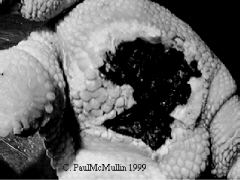



Contact Dermatitis, Hock Burn, Pododermatitis
Introduction
Contact dermatitis affects skin surfaces which have prolonged contact with litter, the foot pad, rear surface of the hock and, when severe, the breast area. It is seen in growing broiler chickens and turkeys, and in broiler parents.
Contact dermatitis is commonly monitored at processing as a means of measuring 'welfare status'. Some lesions are superficial, whereas others progress to deep ulcers so the size, stage of resolution and severity of lesion is likely to affect the degree of discomfort or pain suffered.
Pododermatitis is often related to high droppings pH, level of soya bean meal in feed (according to some authors, stickiness of droppings), and, most importantly, litter moisture. It can be reproduced by adding water to the litter.
Signs
- Blackened skin progressing to erosions and fibrosis on the lower surface of the foot pad, at the back of the hocks, and sometimes in the breast area. If severe the foot and hock lesions may contribute to lameness or serve as a portal of entry for secondary infections.
Post-mortem lesions
- As described under signs.
Diagnosis
Signs and lesions.
Treatment
Not applicable.
Prevention
This condition is closely linked to intestinal function as this is the prime determinent of faecal consistency and stickiness. See the discussion in the section on Dysbacteriosis.
Choice of drinker type (nipple as opposed to bell), drinker management, proper insulation in cold climates, and adequate ventilation to remove moisture are all important.
 |
| Figure 18. Moderate pododermatitis on a foot pad. |







